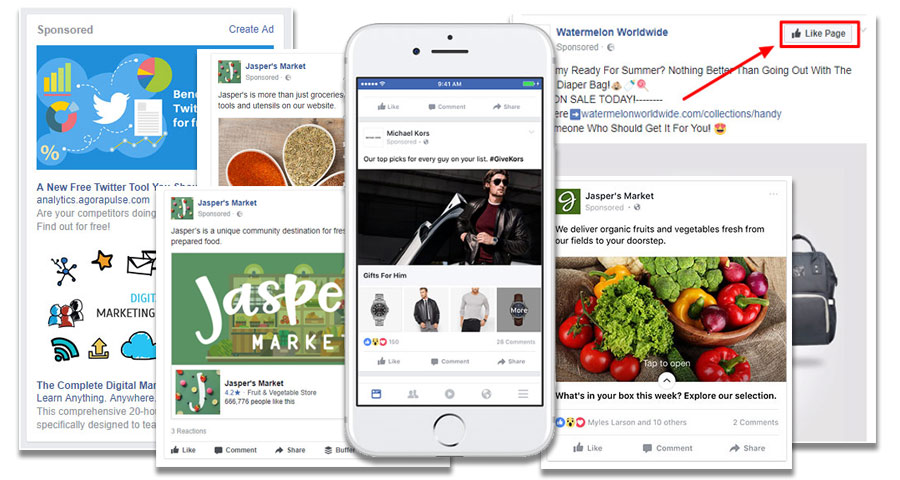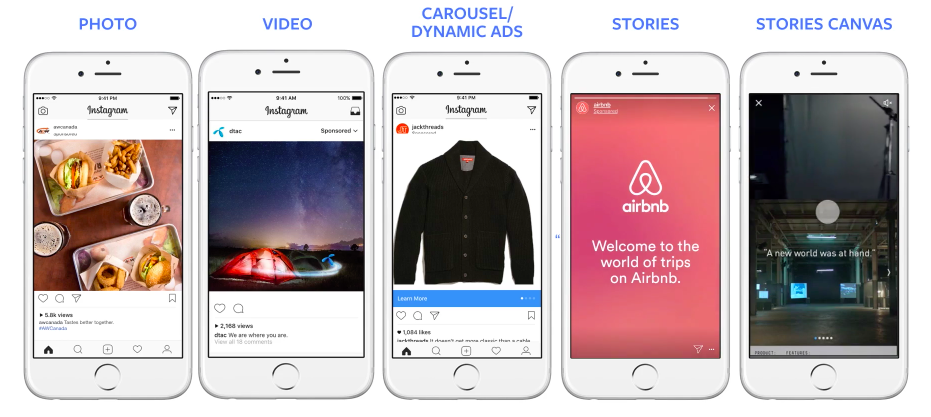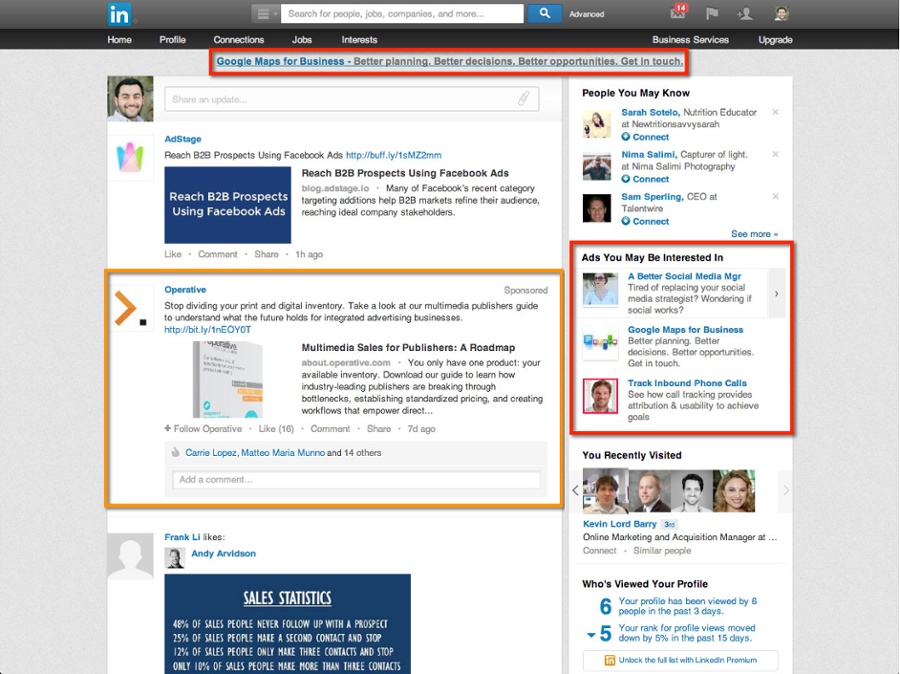Back to days when small businesses relied on Yellow pages and the local newspaper for advertising. It was expensive, not trackable and commonly, not effective.
However, in today’s digitalised world, online advertising has changed the face of promotional efforts with a vast array of options for you to choose from that are affordable, trackable and VERY effective if done right! On that note, as a first-time user, this could be quite confusing and overwhelming.
So in today’s article, I’ll be showcasing all the different types of online advertising platforms that you can use – suited to your business needs, and give you my tips so you can use it in the most efficient way to attract leads and generate new customers for your business.
Understanding your Ideal Customers and Aligning Your Business Objectives to Digital Marketing Strategy
If you’ve read any of my previous blogs (if you haven’t, go check them out!), I’m sure you’ll know by now, the most fundamental step is always – understanding your ideal customer.
Without taking the time to understand your customer, all advertising activity will be like taking a shot in the dark – extremely dangerous and ineffective. That is why, creating a digital marketing strategy that is aligned to your business goals and is tailored to your customers and their needs, will help you achieve the results you want.
There is a lot of noise out there, with more than 500 million tweets, 95 million Instagram photos, and videos and 4.5 billion likes on Facebook daily. As a business, what can you do to stand out from the crowd?
The first thing of all things is to understand your current and potential customers; who they are, what they need, what they like, where they are, what their pain points are and what are their common consumer behaviour. By truly understanding your ideal customer, you’ll be able to create resonating content for your advertisements.
To read more on understanding your customers and building customer personas, check out here.
Now that you know how to stand out from the noise, how do you choose the most suited online advertising platform for your business?
What Are My Options?
Here’s the fun part. Kind of like speed dating, I’ll be introducing you to each online advertising platform – their good traits (benefits), popularity (target range, mobile traffic), costs (organic or paid) and trackability (analytics).
When considering each platform, keep in mind your target audience and budget – you don’t want to be overspending in places that aren’t going to give you the sales.
Social media marketing
With hundreds of millions of users on social media portals like Facebook, Instagram, Twitter and LinkedIn, social media marketing make it an excellent channel for brand exposure.
Almost 3 in 5 Australians interact with companies of social networks, and 93% of social media users read online reviews before making their purchase.
However, it is important to remember that just because there is a network of billions of users, it may not be the right one for your company.
Instead of trying to promote to everyone, focus on the networks that are relevant to your business and where your ideal customer will engage on. Rather than having a lacking presence on all the networking platforms, have a strong digital presence on one!
Facebook ads
Main Audience:
Approximately 77.7% of the Australian population is an active Facebook user. Although Facebook is predominantly made up of millennials, (as of January 2022, 11.5 million Australian Facebook users were aged between 25 and 34), this social media platform attracts adults from all age groups, with 1 in 5 adults over the age of 65 using Facebook.
Target range:
Advanced advertising options include demographic targeting (gender, age, income, ethnicity), user behaviour (interests, likes and dislikes), geo-targeting (current location, target location), competitive targeting (targeting your competitors’ Facebook users) etc. With advanced advertising options and the richest user data, this makes the audience reach extremely efficient and easy.
Analytics:
Like Google Adwords, Facebook Ads are also trackable. With Ads Manager, you’ll be able to analyse the performance of your ads and see which advertising elements work well and which don’t. This will help determine what needs changing to help you optimise for optimal performance.
Content:
The content for Facebook differs from Google Adwords. The key to Facebook advertising is balancing valuable content with fun and shareable content.
Remember, you’re on social media so don’t forget to make your ads interactable with your audience. Try different types of ads and content i.e. short headline and compelling message, emotional videos, quality images, relatable questions, clear call to action button and of course, sprinkle some of your brand’s personality!
Instagram ads
Main Audience:
A social network that appeals more to the youth, Instagram is predominately made up of Gen-Z and Millennials (age 18-34), it is also used more by females, with around 49.3% of women on Instagram daily.
Target range:
Like its parent company Facebook, Instagram allows for the granular control to target demographics, locations, interests, behaviours etc. Also like Google Adwords, it allows you to target a custom audience like your direct list of leads or people who have similar interests to your target audience.
However, consider this. Instagram has shown to be more skewed towards a younger audience; mainly between the ages of 18-29 (55%), and 30-49 (28%). Only 11% of users are between 50-64 and 4% being over 65.
Location wise, a majority of Instagram users live in urban area. Understanding this is important, however the most important thing is understanding your customers. If your target audience mainly uses Instagram despite the facts shown above, don’t let this discourage you.
Analytics:
Like Facebook ads, you can understand the performance of your Instagram ads in Facebook Ads Manager and the Instagram App.
You’ll be able to learn the general activity of your posts; how many interactions, how many profile clicks – were they organic or paid, is the majority of your viewers male or female, how old are they, where are they located, what popular times does your audience engage at etc.
Content:
Since Instagram is such a visual platform, text messages won’t work like how it does on Facebook and Google. One of the most popular ad formats is single photo ads – this is a single image that has a brief description and a variety of hashtags.
Instagram Reels have a way of grabbing attention, which can help boost brand engagement. These full-screen vertical videos can be up to 90 seconds and feature unique editing tools and an extensive library of audio tracks. On top of sounds, Reels can include multiple clips, filters, captions, interactive backgrounds, stickers, and more.
Unlike Stories, Reels don’t disappear once posted, and the algorithm is more likely to recommend them to people who don’t follow your brand than feed posts.
Hashtags are great to enhance your brand’s exposure because your ads will appear when users search for that topic. Instagram also offers different ad formats including video ads, multiple photo carousel ads and collection ads which will help enhance the customer’s experience.
LinkedIn Ads
Main Audience:
If you’re a B2B brand, LinkedIn would probably be the best platform for you. Known to be the network for professionals, LinkedIn is perfect to target users who have a business mindset.
Target range:
Unlike Google, Facebook and Instagram ads, we find LinkedIn typically more expansive and is able to target audiences by industry-specific variables. Variables include job title, job function, seniority, company names, company size, industry, skill, and degree type and name. By profession and industry, LinkedIn is the only social media platform that offers these targeting opportunities.
Analytics:
You can analyse LinkedIn ad performance through Campaign Manager. Here, you’ll be able to see the performance of your ads; how many generated leads, purchases and event registrations. You’ll also be able to compare metrics like clicks, impressions and social activity so see which campaigns are working and which aren’t. Not to forget, you’ll also be able to understand your customer a bit more with greater insights into your customer’s demographics.
Content:
For LinkedIn Sponsored Updates, because they appear on the user’s Newsfeed, its crucial to incorporate a visual component and a link to your landing page. Visuals tend to enhance the user’s experience which will lead to higher engagement. According to LinkedIn, adding images to your ad can increase your clicks by 20%.
LinkedIn ads can be formatted through images, video or text. Like Instagram, use hashtags as they can help your audience find you when they search for your topic.
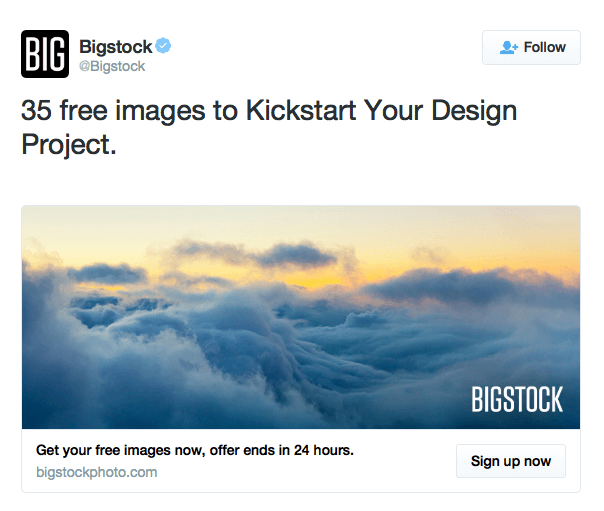
Twitter ads
Main Audience:
With a much smaller user base compared to other social media giants (3 million monthly users), Twitter is demographically skewed to the younger, urban, early adopting, well-educated men and engages dominantly on a global scale compared to the Australian market. For small businesses, this may not be the right platform for you. Do your research and consider whether Twitter is the right platform for your business.
Target range:
Twitter offers various targeting options like language targeting, demographic targeting, interest targeting, device targeting, behaviour targeting and followers targeting (helps target followers of relevant accounts who are likely to be interested in your content).
Analytics:
Twitter analytics can help you better understand the performance of your ads. There are three places you can find this at the top of your dashboard; Account home, Tweet Activity Dashboard and Audience Insights Dashboard.
In the account home, you’ll be able to find your top performing tweets, as well as the top influencers in your network.
In your Tweet Activity Dashboard, you’ll be able to understand how many people have seen, retweeted, liked and commented on your tweets.
In your Audience Insights Dashboard, you’ll be able to learn about your follower’s interests and demographics.
Content:
Twitter ads come in two types: promoted tweet and Twitter Website Cards.
Promoted tweets are pretty much like a standard tweet except it stays at the top of the user’s stream. To create engaging promoted tweets, be sure to include an image and a strong call to action.
Twitter website cards help you connect your user to your website instantly. By using interesting images alongside a compelling tweet, it can help drive your user to your website where you’ll be able to showcase more information about your brand and products/ services.
Google Ads
Being the world’s most popular search engine, it’s no surprise that Google is such a popular platform to advertise on. However is Google Ads the right platform for you? This will depend on your target audience, your budget and your knowledge of getting results from the Google Ads platform.
Google Ads is a form of paid search advertising – a system that will allow you to place advertisements on search engines (like Google, Bing, Yahoo! etc.) when people search for your products/ services.
Basically like a sponsored ad, each time someone clicks on your ad, you will pay a small fee. That is why paid search advertising is also known as PPC, or Paid Per Click.

Google Ads
Main Audience:
In terms of the use of all Search Engines, Google is heavily favoured by global internet users, averaging a net share of 74.54% in 2017. Focusing on industries, according to Wordstream.com, the average click-through rate in Google Ads falls highest with the dating and personal (3.4%), which is then closely followed after finance and insurance (2.65%), then B2B (2.55%), then Consumers Services (2.4%) and then to Technology (2.38%). This shows that majority of Google users primarily have interests in dating and personal, finance and insurance, B2B, consumers services and technology.
Target range:
Google Ads offers a wide range of options to help you reach the right person at the right time. You can define your target audience by demographic and in the market – in the market can help display your ad to people who are searching for products and services like yours. Google Adwords is also great as it can help display your ads to an audience who have related interests and may lead them to interact with you.
Mobile Traffic:
With over 3.5 billion Google searches per day, Google Ads aren’t just accessible via mobile, but also PC, tablet and TV screen i.e. Chromecast.
Analytics:
Google Adwords is great when it comes to tracking. Google provides great data on how your ads perform so you can understand what’s working well and what isn’t. You can analyse:
- How many clicks each ad has
- Who has clicked your ad
- How many leads have been generated from your ad
- How much traffic has been driven to your website through your ad
- Which keyword gets the most clicks and leads
- How much each lead cost
With this information, you can make adjustments to your Google Adword campaigns to achieve better performance over time, while saving money and effort on ads that aren’t performing
Content
For Google Ads, there is two main type of ads; one is text-based PPC ads that are listed in the search results, and the other is Product Listing Ads that appear in Google Shopping. While the first one is in text, the second one is more visual.
To create a good text backed PPC ad, you NEED a compelling copy and an engaging headline. However, you can be restricted to 70 characters for your copy and 25 characters for your headline. So, it’s important to say what you need to say in a small amount of space and you need to say it well too!
There are 5 main rules for extravagant PPC ad writing:
- Communicate clearly with easy-to-understand language
- Engage with vivid language by tapping into the reader’s emotions
- Focus on keywords and consider negative keywords (words that won’t trigger your ad. This is important because your ads function by cost per click, it will help you exclude search terms so you can focus on the keywords that matter to your customers)
- Make a compelling offer and an enticing Call To Action (CTA)
- Be careful with abbreviations and complex phrases.
Online Retail Marketplaces

Amazon ads
Main Audience:
Online Retail marketplaces are a great place to promote your products and services because they’re more targeted towards your specific audience and are dependent on differing industries. Popular online marketplaces include Ebay, Amazon, Gumtree, Carsales, Catch, Airbnb, Ubereats, Alibaba, AliExpress etc.
These platforms can be used in an extremely targeted way for small businesses, and often may not have any upfront costs for listing, however, most will charge a certain percentage after a sale is made.
Target range:
Target range will differ across different online marketplaces. However if you do your research, and is able to identify a platform where your consumers use and engage on, you’ll most likely be able to target your audience well. Many of these online marketplaces would only be able to differentiate your products by keywords. Unlike social media, you won’t be able to target according to a variable such as demographics, interests and, behaviours which can be quite limiting to your reach.
Analytics:
Some marketplaces offer analytics. For example, eBay lets you quickly analyse the important performance metrics of your product listings so you can see if your campaigns are performing to your expectations. In the performance report, you’ll be able to understand the click to sales rate, your return on investment and your promoted listings contribution.
Content:
On online retail marketplaces, it is generally quite common that your promotions are displayed as listings. That is why it is important to use a clear compelling title and a good image that portrays your products clearly. The price here is also important as it is generally the deciding factor who users on these platforms. So have a clear price or promotional offer that will entice your consumer.
Local Online Advertising platforms
Please focus your resources on platforms that have traffic – where your ideal customers will be. For example, Sonia Wray from Sterling Fitness acknowledged that her ideal customers who were adults over the age of 50 living in Northern Sydney who loved working out and hiking, read the local digital newspaper.
Her decision to advertise in the Chatswood local newspaper helped her gain amazing reach, plus advertising was free! Check out your local newspaper and community portals and websites because you never know, they may promote your business to your ideal customers for free, or minimal charge!
- Local digital newspapers
- Community portals and websites
- Local Business Chambers of Commerce
Retargeting marketing
Retargeting is a very powerful way to redirect traffic back to your website. Retargeting works by reminding customers, who have been to your website, about your brand and your offering. Unlike all the other ads mentioned in this blog, Retargeting is retention focused rather than acquisition. It is one of the best advertising strategies because it brings backs visitors who were once hesitant to buy your product or service.
An Adobe study has shown that you can increase the click-through rate by 400% and revenues by 200% by attracting traffic that has already visited your website (lyfemarketing.com). At a low cost, retargeting is automated, effective and revenue-boosting.
See below to see how it works:
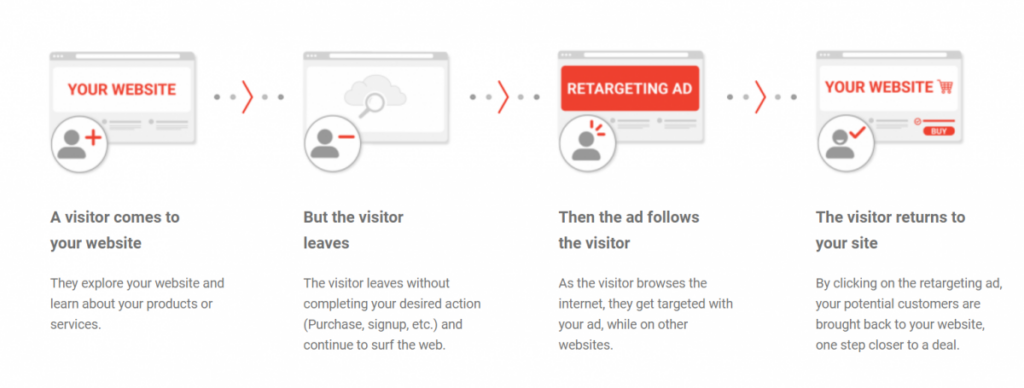
Target range:
Retargeting is great to bring back hesitant customers who aren’t ready to commit to purchasing. How retargeting works is when new visitors come to your website, a tracking pixel that serves as your ad will follow them wherever they go.
Content:
Retargeting ads are predominately display ads. Display ads are visual advertisements that can be placed on a variety of online media. Display ads come in a wide array of formats such as text, images, video, flash, and more.
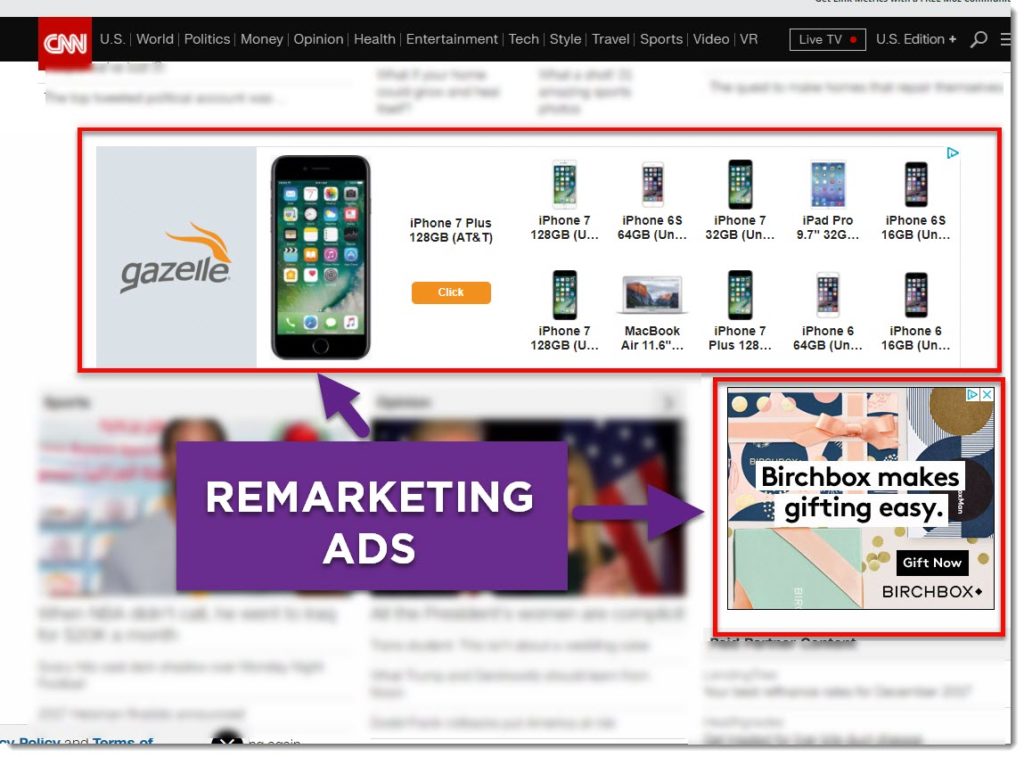
The best way to display your retargeting display ads, consider these:
- Have a clear CTA
- Good Hero Image
- Company logo
- Great branding
- Promotional offer
- Sense of urgency
- Catchy Headline
- Match your landing page to your ad
- Choose the right sizes i.e. 300×250 b. 160×600 c. 728×90 d. 600×315 (Facebook)
- Always be testing to assure the most effective retargeting ads
Conclusion
With so many advertising platforms to choose from, it can be hard to decide which one is most suitable for your business. Hopefully, from this article, it’ll provide you with an outline of what each advertising platform offers and the tips and tricks to you need to succeed in your advertising strategy.
Hope you have enjoyed and gained insight from this article. Join our Netstripes community on Facebook, Instagram, and LinkedIn and stay up to date with the newest marketing trends, tips, and events.
Originally published March 19, 2019, updated September 01 2022

Your first step to building a world-class website starts here.
A trusted brand is priceless for any business. We will help you build a compelling website that is respected in your industry and stands apart from your competition.

